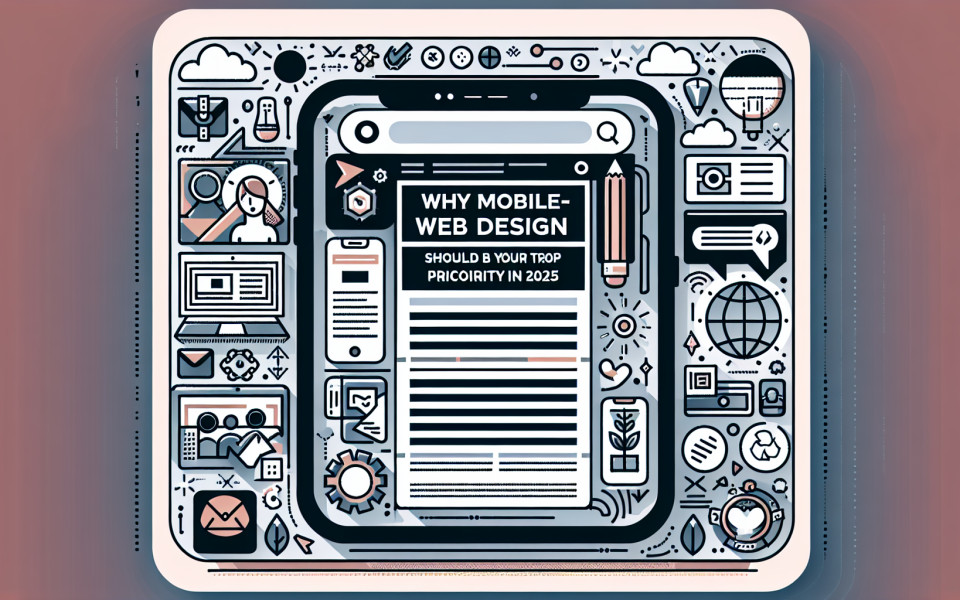
Why Mobile-First Web Design Should Be Your Top Priority in 2025
In the fast-evolving digital landscape, prioritizing Mobile First Design has become more crucial than ever. As we approach 2025, the dominance of mobile devices in accessing the internet continues to rise, making it imperative for businesses and developers to rethink their web strategies. This article, part of Web & App Development Insights, explores why adopting a mobile-first approach is not just a trend, but a necessity for staying competitive and ensuring exceptional UI/UX Design.
The Evolution of Web Access: Mobile Takes the Lead
Over the past decade, the shift from desktop to mobile browsing has been undeniable. Statista reports that mobile devices accounted for over 58% of global website traffic in 2024. As these numbers are expected to climb in 2025, building with a Mobile First Design mindset is no longer optional—it's essential for businesses targeting modern consumers.
- Mobile First Design ensures your site loads quickly and efficiently on smartphones and tablets.
- Prioritizing mobile usability leads to better UI/UX Design and user satisfaction.
- Google and other search engines favor mobile-optimized sites in their rankings.
What is Mobile First Design?
Mobile First Design is a strategy where web designers and developers start the design process with the smallest screen in mind, gradually scaling up for larger devices. This contrasts with traditional methods, which often prioritize desktop layouts first, making mobile adaptations an afterthought.
- Design begins with essential features and content for mobile users.
- Progressive enhancement adds complexity for tablets and desktops.
- UI/UX Design tailored to mobile devices leads to intuitive navigation and faster interactions.
Why Mobile First Design Matters in 2025
1. User Expectations and Behavior
Modern users expect seamless experiences across all devices. A Mobile First Design approach ensures that users on smartphones and tablets encounter a streamlined interface, clear calls to action, and easy navigation, which are all pillars of effective UI/UX Design.
2. SEO and Search Engine Ranking
Search engines like Google have adopted mobile-first indexing, meaning they primarily use the mobile version of a site for ranking and indexing. Websites optimized through Mobile First Design are more likely to achieve higher visibility in search results, directly impacting traffic and engagement.
- Mobile First Design improves load times, reducing bounce rates.
- Well-implemented UI/UX Design increases dwell time, signaling content relevance to search engines.
3. Enhanced UI/UX Design
A focus on UI/UX Design within a Mobile First Design framework leads to visually appealing, accessible, and user-friendly layouts. Elements such as larger touch targets, simplified navigation, and responsive images contribute to a superior user experience, which is critical for customer retention and brand loyalty.
The Business Benefits of Adopting Mobile First Design
Adopting a Mobile First Design approach offers tangible benefits for businesses across industries. Not only does it future-proof your website against evolving technology, but it also positions your brand as modern, accessible, and user-focused. Here’s how:
- Increases reach to the growing number of mobile users.
- Boosts conversion rates by optimizing UI/UX Design for mobile interactions.
- Reduces development and maintenance costs through streamlined, responsive code.
How to Implement Mobile First Design Effectively
1. Start with Content Prioritization
Identify the most crucial content and features for mobile users. By focusing on essential elements first, you prevent information overload and ensure that your UI/UX Design remains clean and functional.
2. Embrace Responsive Frameworks
Utilize frameworks like Bootstrap 5, which are built with responsiveness in mind. These tools help maintain consistency and flexibility across devices, reinforcing your Mobile First Design and optimizing UI/UX Design.
3. Continuous Testing and Optimization
Regularly test your website on a variety of devices and screen sizes. Gather user feedback and analyze analytics to identify areas for improvement in both Mobile First Design and UI/UX Design.
Why Choose Professional Help for Mobile First Design?
While templates and DIY solutions exist, achieving top-tier Mobile First Design and outstanding UI/UX Design often requires expert guidance. Partnering with a team specializing in Web Design And Development ensures your website is both beautiful and functional across all platforms, maximizing your competitive edge in 2025.
Conclusion
As mobile usage continues to outpace desktop browsing, prioritizing Mobile First Design is no longer just a best practice—it’s a critical strategy for success in 2025 and beyond. By focusing on superior UI/UX Design, businesses can deliver exceptional digital experiences, improve search rankings, and foster lasting customer relationships. Stay ahead of the curve by making Mobile First Design your top priority and leveraging professional services like Web Design And Development to realize your vision.






